Fish on Good Friday - The Basque way...
Thursday, April 10, 2025
Bacalao a la vizcaina is yet another example of the very tasty yet very simple dishes that come from the northern Spanish region of the Basque Country. The main ingredient of Bacalao a la vizcaina is codfish. Cod is perhaps one of the most consumed fish in Spain, although historically this fish was mostly a product eaten during Lent. It is also a fish that is easily fished around the coasts of Spain, of which there is a lot!
 Originally from the Basque Country, Vizcaina sauce on the other hand, is a sauce that is extremely versatile and is used in a number of dishes from the region. It is often used for many stews and products such as the pork dish called 'Manos de cerdo con salsa vizcaína'. In some parts of the Basque Country, they even use the sauce in an escargot recipe. However, most people will associate the sauce immediately with cod. Nowadays it is a rather polemic recipe - as is the case with most traditional recipes - the argument whether tomatoes should be one of it's ingredients or not is a very alive debate among gourmets and cooks, though many say that the red ingredient is pepper. Either way, the sauce is a rich red colour and is tasty with either ingredient. So when you come to make this dish, the choice is up to you! Originally from the Basque Country, Vizcaina sauce on the other hand, is a sauce that is extremely versatile and is used in a number of dishes from the region. It is often used for many stews and products such as the pork dish called 'Manos de cerdo con salsa vizcaína'. In some parts of the Basque Country, they even use the sauce in an escargot recipe. However, most people will associate the sauce immediately with cod. Nowadays it is a rather polemic recipe - as is the case with most traditional recipes - the argument whether tomatoes should be one of it's ingredients or not is a very alive debate among gourmets and cooks, though many say that the red ingredient is pepper. Either way, the sauce is a rich red colour and is tasty with either ingredient. So when you come to make this dish, the choice is up to you!
The pepper theory seems historically more plausible, as tomatoes were not used as food in Spain even 200 years after they were imported; first, they were used as ornamental plants. Perhaps, pepper was used originally and then, once the tomato became more commonly used in Spanish cooking, the sauce was adapted. But it doesn't really matter, in truth, there are many formulas to prepare this sauce, and despite how much people may argue about its historical accuracy, they are delicious anyway.
You might find that certain people use a type of Spanish biscuit, often a 'galleta maria', when they are making the sauce. These biscuits are used to help thicken the sauce, but it can often make it much sweeter. The sauce may be thick or runny, depending on your personal taste. If you don't want to use biscuits to thicken your sauce, you could always use plain or corn flour instead, which I prefer.
One of the great things about vizcaina sauce is that it is fairly simple to make and generally uses common and inexpensive ingredients. This means that it is a great option for those people who love Spanish gastronomy, but want to enjoy it on a budget!

Bacalao a la Vizcaina | Cod Bizcaine Style
Ingredients:
1 large salted cod loin (or fresh cod loin)
1 large onion
2 garlic cloves
2 roasted peppers (preferably chorizo peppers
1 tomato
1 tbs of flour
Extra virgin olive oil
Preparation:
- Soak the cod loin in water for 24 hours, changing the water every 8 hours to get rid of some of the salt.
- Then put the cod loin in a pan with cold water and heat. Remove from the heat when it begins to boil.
- Cover the bottom of a frying pan with olive oil. Stir fry the diced onion until it begins to brown, then add the garlic cloves, peppers and tomato.
- When all the ingredients are lightly fried add the flour, you need to cook it a little.
- Add some of the broth in which the cod was cooked (two teacups) and let it boil at low heat. This broth has the flavour and jelly of the cod.
- When the sauce gets a good thick consistency, add the cod and keep on low heat, only enough time to heat up the cod and then serve!
Enjoy!
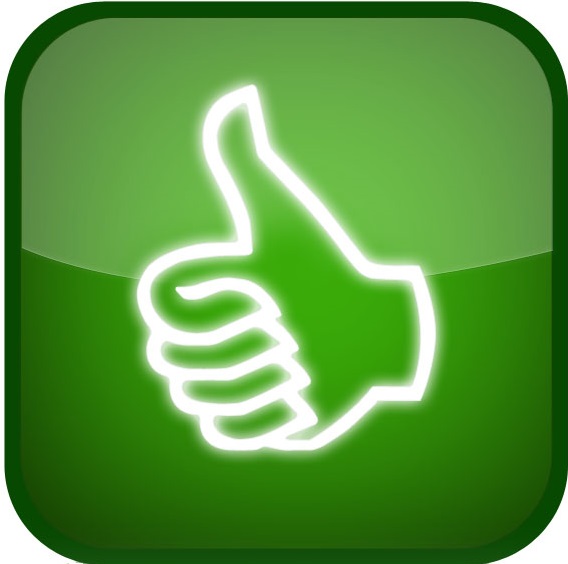 1
Like
Published at 11:35 PM Comments (0)
1
Like
Published at 11:35 PM Comments (0)
Strawberries in season
Saturday, April 5, 2025

Strawberries are in season! The earliest varieties have already appeared on the shelves of supermarkets and, strawberries are typically a spring fruit that we love to enjoy at this time of year in a thousand different ways. Full of virtues, they have a small drawback: they are very delicate and spoil quickly. To extend their life we can apply simple steps at home that will avoid the annoyance and wastefulness of having to throw them away, especially as strawberry punnets tend to be fairly big in Spanish supermarkets.
We need to be aware that strawberries are non-climacteric fruits, that is, they no longer ripen once they have been collected, unlike apples or bananas. This means that when we buy them, they have already started to deteriorate and lose quality, and it is something that will only become more pronounced as the days go by. The key, therefore, is to buy them at the optimal time and conserve them properly to slow down this deterioration process.
Don't be carried away by temptation unless you know you are going to be able to consume all the strawberries in a short period of time. If we decide to buy them, as always, it is convenient to check the labelling to know the collection date or packaging date, and thus choose the most recent. It is also important to examine the strawberries carefully as well.
 It is preferable to choose strawberries that are not too tightly packed, in rigid and protected containers that allow you to see the contents clearly. Check that there are no mouldy, stale or pieces that are too green, that they are not crushed or apparently damaged. Very green or white fruit will no longer ripen, and old fruit will likely show dark spots, cracks, or a loss of juices as the strawberries start to weep with time. It is preferable to choose strawberries that are not too tightly packed, in rigid and protected containers that allow you to see the contents clearly. Check that there are no mouldy, stale or pieces that are too green, that they are not crushed or apparently damaged. Very green or white fruit will no longer ripen, and old fruit will likely show dark spots, cracks, or a loss of juices as the strawberries start to weep with time.
When in the trolley they need to be treated with care and never put other objects on top. If possible, keep them at the top, away from damp or very fragrant food, and also separated from apples and bananas, which emit ethylene.
Although they are at room temperature in the store, strawberries, like berries and other delicate fruits, must be refrigerated. The sooner we get them in the fridge, the better, and always without washing. Strawberries should only be washed just before eating, as the humidity would only accelerate their deterioration.
Once at home, you should open the container and check them one by one, discarding those that may have mould or very visible damage. The most strawberries that are most mature should be separated and consumed quickly.
Mouldy or rotten fruits must be thrown away. It is not safe to cut off the rotten or mouldy part as fungi are dangerous pathogens that spread through the food.
Do not remove the stems, as it would be an easy entry point for microorganisms. This can be applied, as a general rule, to all plant products.
Place the fruit in a clean, spacious container, preferably in one which allows them to be arranged in a single 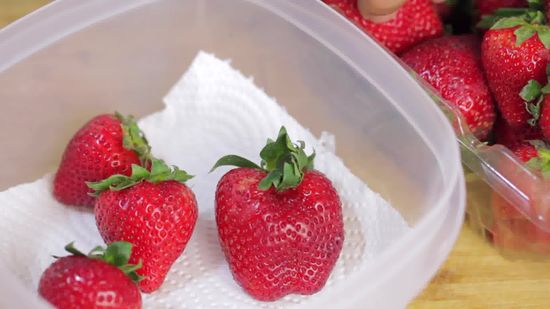 layer, without piling them up. If we have too many, you can always split them between two containers. layer, without piling them up. If we have too many, you can always split them between two containers.
We can line the bottom of the container with kitchen paper or with a special cloth for preserving vegetables, such as those sold for refrigerator drawers. This allows air to circulate and will absorb any possible moisture that is released.
Strawberries need to "breathe" so you should never close them tightly. If we want to cover them, make sure you leave access for air to circulate freely.
Inside the refrigerator, ensure that they are kept at a constant cold temperature, never lower than 2ºC, and not higher than 6ºC. Again, away from foods that emit strong odours or ethylene.
Strawberries will keep fresh like this for between four and five days, but it is always advisable to check the status of all fruits daily, to quickly discard any specimen that shows signs of mould or any deterioration.
 2
Like
Published at 1:31 AM Comments (0)
2
Like
Published at 1:31 AM Comments (0)
The Smallest Window in the World - Toledo's Tiny Marvel
Friday, March 28, 2025
In the heart of Spain, hidden within the winding cobblestone streets of Toledo, lies a peculiar architectural wonder that has captured the imagination of locals and tourists alike. This minuscule marvel, barely visible to the untrained eye, holds the prestigious title of "The Smallest Window in the World." But what makes this diminutive opening so special, and why has it become such a captivating attraction in a city already brimming with historical treasures?
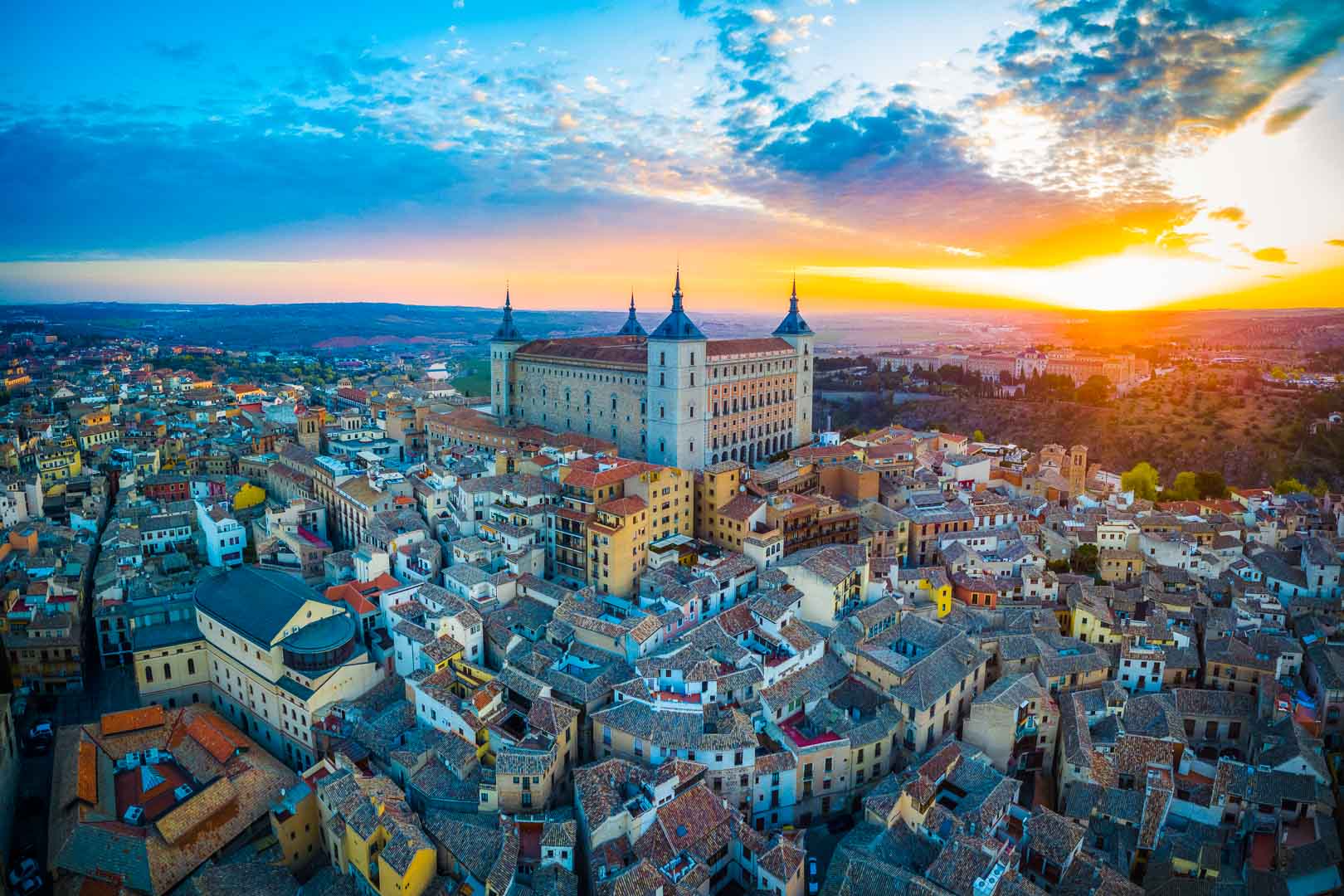
Before we delve into the intriguing tale of the world's smallest window, let's set the stage by exploring the enchanting city that houses this unique feature. Toledo, often referred to as the "City of Three Cultures," is a UNESCO World Heritage Site that has been captivating visitors for centuries. Perched atop a hill overlooking the Tagus River, this ancient city has been a melting pot of Christian, Muslim, and Jewish influences, each leaving an indelible mark on its architecture, culture, and spirit.
As you wander through Toledo's narrow, labyrinthine streets, you'll find yourself transported back in time. The city's skyline is dominated by the imposing Alcázar fortress and the majestic Gothic cathedral, while its streets are lined with well-preserved medieval buildings, synagogues, and mosques. It's within this rich tapestry of history that our tiny protagonist, the world's smallest window, resides.
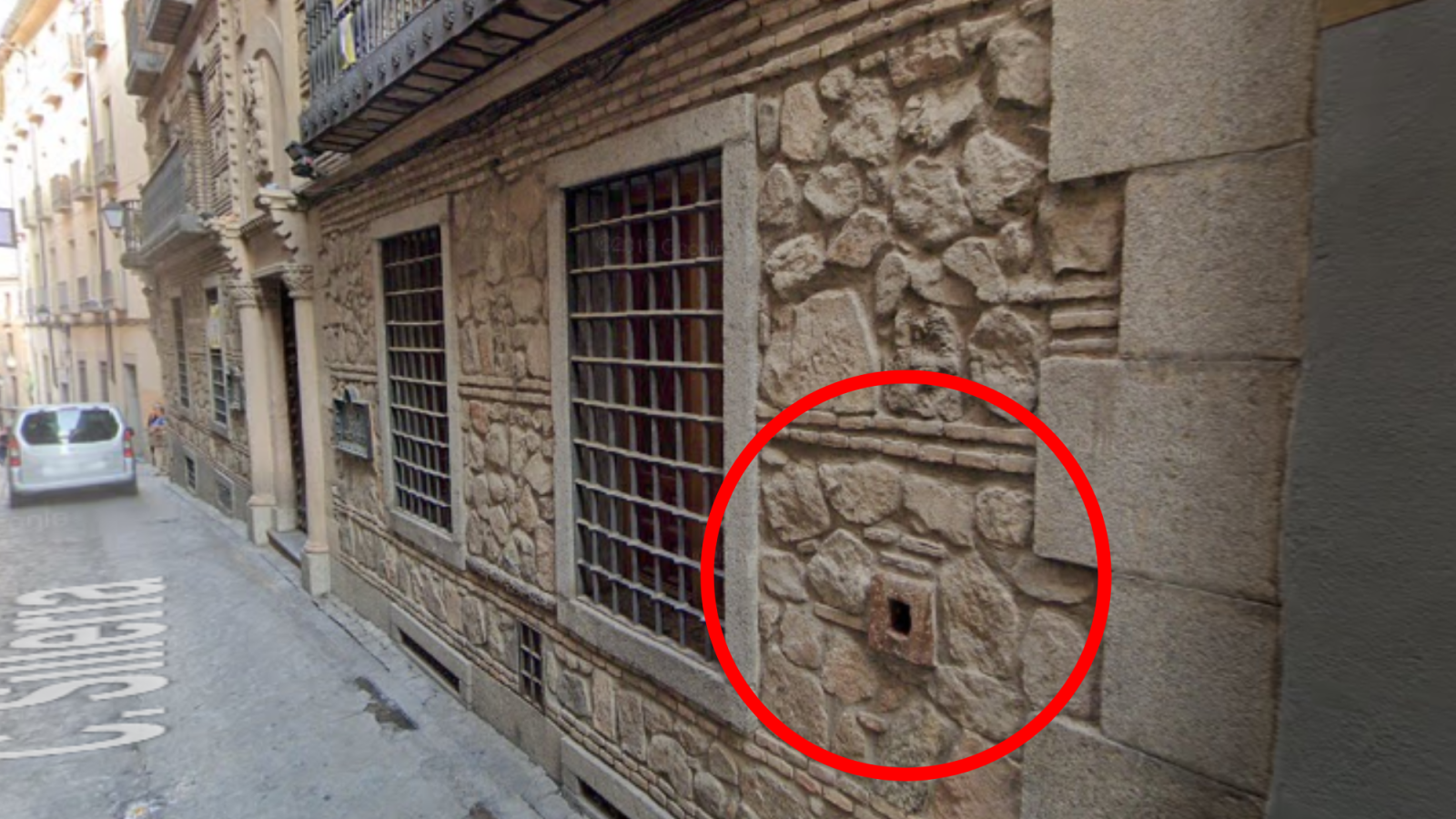
Tucked away on Calle Sillería (Sillería Street) at number 3, the world's smallest window is easy to miss if you're not actively seeking it out. This minuscule architectural feature is set into the wall of a 16th-century building known as the Casón de Los López. Once a grand Toledo residence, this historic structure now stands as a testament to the city's rich past and houses this peculiar claim to fame.
The window itself is truly a sight to behold – or rather, a sight you might struggle to behold without getting up close and personal. Smaller than the palm of an adult's hand, this tiny aperture has been officially recognised by the Guinness Book of World Records as the smallest window in the world. Its diminutive size begs the question: what could possibly have been its purpose?
The true function of this tiny window remains shrouded in mystery, sparking countless theories and legends among locals and historians alike. Some speculate that it might have served as a discreet peephole, allowing the occupants of the house to observe the street without being seen. Others suggest it could have been a clever way to pass small objects or messages in secret.
Adding to the intrigue is an inscription at the base of the window. Some claim it reads "Thank you, Allah" in Arabic, while others insist it says "Talaytula," the former Arabic name for Toledo. This cryptic message only deepens the mystery surrounding the window's origins and purpose.
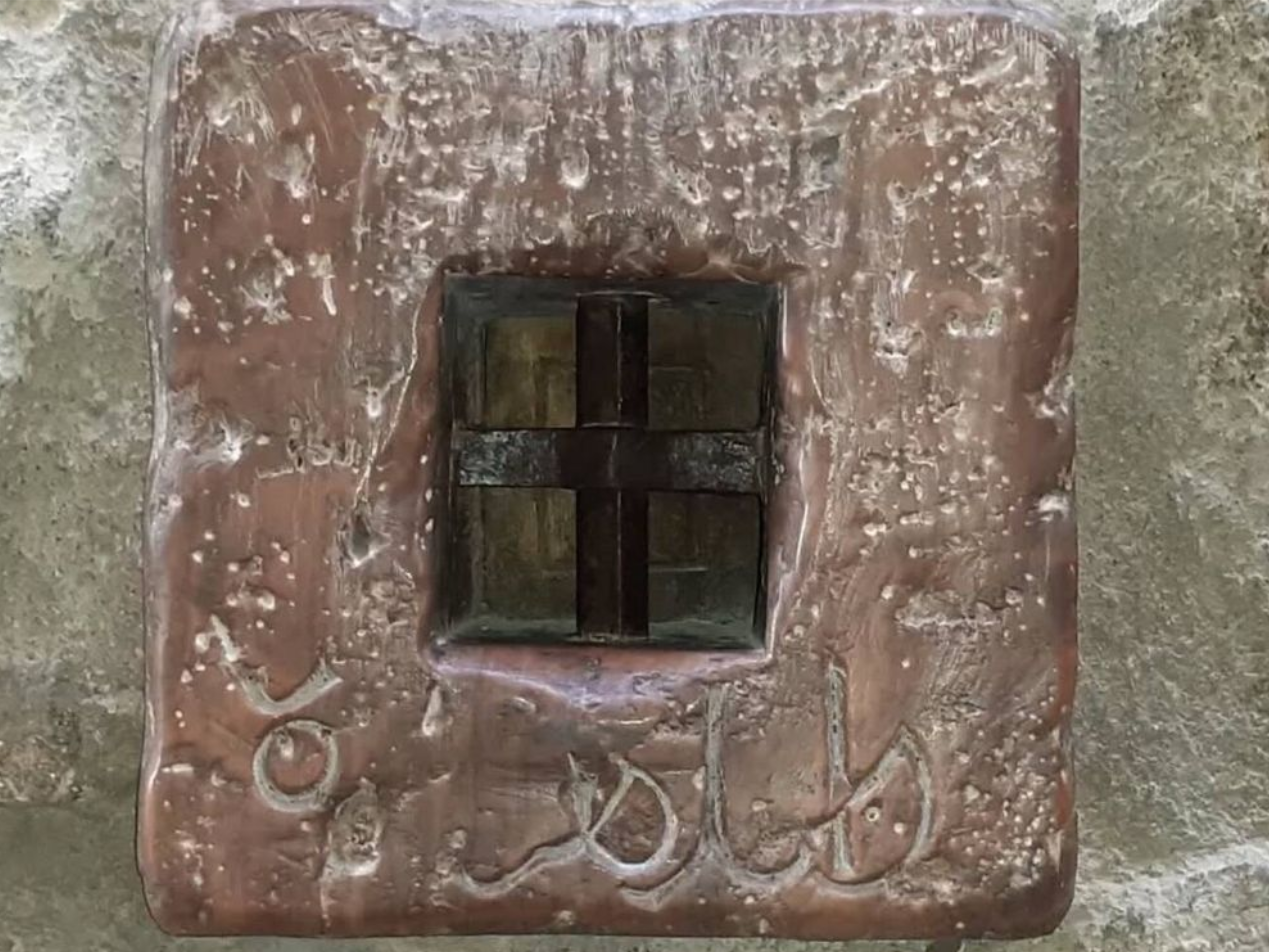
Regardless of its original function, the world's smallest window has become a symbol of Toledo's rich history and the fascinating blend of cultures that have shaped the city over the centuries.
The building that houses this miniature marvel, the Casón de Los López, is itself a fascinating piece of Toledo's architectural heritage. Dating back to the 16th century, this structure offers a glimpse into the grandeur of Toledo's past.
In 1973, the building underwent a careful restoration, preserving its historic character while adapting it for modern use. For many years, it housed a restaurant, allowing visitors to dine in the shadow of centuries-old walls and, of course, catch a glimpse of the world's smallest window. Although the restaurant has since closed, the building remains an important landmark in Toledo's old city.
Interestingly, just to the right of the famous tiny window, there's another, larger window that looks into the interior of the Casón de Los López. This juxtaposition of sizes serves to emphasise just how remarkably small the world-record-holding window truly is.

While the world's smallest window may be one of Toledo's more quirky attractions, it's far from the only hidden gem in this historic city. As you explore the winding streets and ancient squares, you'll discover countless other fascinating details that speak to Toledo's rich past.
From intricate Mudéjar designs adorning centuries-old buildings to hidden courtyards bursting with fragrant orange trees, Toledo is a city that rewards curious explorers. The smallest window is just one example of the many surprises that await those willing to look a little closer and dig a little deeper into the city's history.
In a world that often celebrates the biggest, the tallest, and the most grandiose, there's something refreshingly humble about Toledo's claim to fame. The world's smallest window reminds us that sometimes, it's the little things that capture our imagination and stick in our memory.
This tiny architectural feature has become a symbol of Toledo's ability to surprise and delight visitors. It represents the city's attention to detail, its preservation of history, and its celebration of the unique and the unusual.
 2
Like
Published at 12:22 PM Comments (0)
2
Like
Published at 12:22 PM Comments (0)
The Arab Baths in Girona
Friday, March 21, 2025
Nestled at the foot of Girona Cathedral, the Arab Baths of Girona offer an intriguing glimpse into medieval history and architectural prowess. Despite their name, these baths are not of Arabic origin but embody a rich fusion of cultural influences that span Roman, Islamic, and Jewish traditions. Built in the 12th century, the baths stand as a testament to the architectural and cultural exchanges that were taking place in medieval Spain.
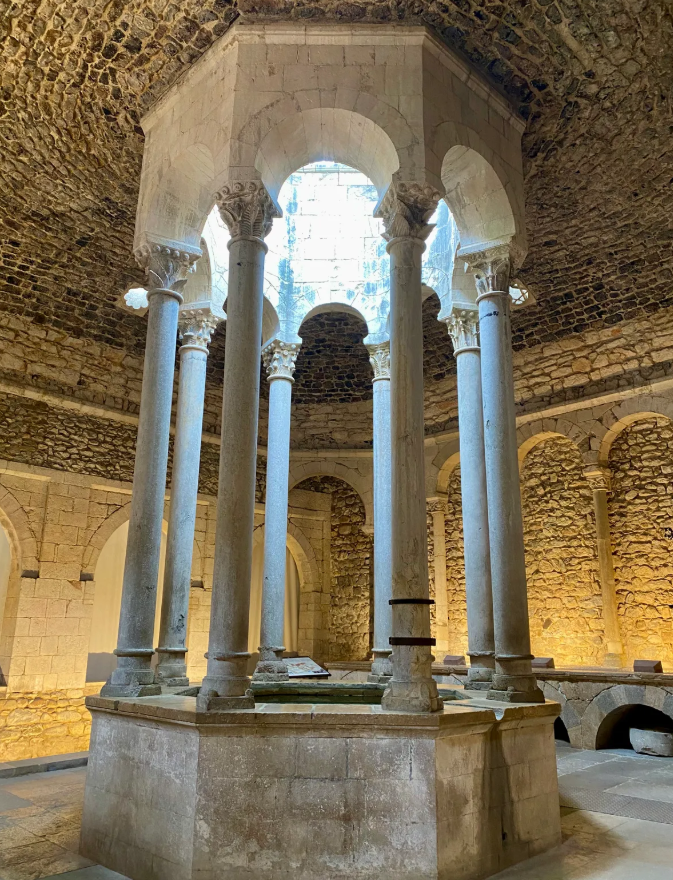
A Confluence of Cultures
The Arab Baths of Girona, constructed in the Romanesque style, were inspired by Roman baths, Muslim hammams, and Jewish mikvahs. This eclectic mix of architectural influences served not only a hygienic purpose during a time of significant urban development but also reflected the broader cultural and religious dynamics at play in medieval Spain.
The architectural design is both functional and aesthetically pleasing, comprising several rooms, each with a specific function. Visitors first step into a vestibule leading directly to the apodyterium, or dressing room. This room is particularly striking due to its octagonal layout, supported by eight slender columns adorned with decorative capitals. Central to this space is a small pool, dramatically lit by a lantern-lit dome overhead. Beyond here, visitors would find the frigidarium for cold water immersion, the tepidarium for warm bathing and relaxation, and the caldarium, offering a sauna-like experience.
From Ruin to Resilience
The baths operated as public amenities until the 14th century, playing a crucial role in the community. They faced partial destruction over the years due to wars and sieges. In the 13th century, recognising their importance to the cultural fabric of the area, King James II ordered their reconstruction. Over time, the baths served Jewish purification rituals and later found new life under the stewardship of Capuchin nuns.
By the 20th century, the baths had undergone a period of careful restoration to preserve their architectural and historical significance. These efforts have ensured that the baths continue to stand proudly today, offering visitors a window into the past and a richer understanding of the cultural exchange that defined medieval Spain.

An Architectural Gem
Today, the Arab Baths attract numerous visitors who come to admire their unique blend of Romanesque and Islamic design features. The architectural highlights are many, but few can rival the intricately carved capitals or the stunning octagonal temple-like structure of the apodyterium.
Guided tours are available for those keen to delve into the historical functionalities and significance of these ancient bathing structures. The tours offer a detailed exploration of each room and its purpose, underscoring the baths' role as both a social and functional hub in medieval society.
Practical Information for Visitors
Visitors planning to explore the Arab Baths will find them open from Monday to Saturday, 10 a.m. to 6 p.m., and on Sundays from 10 a.m. to 2 p.m., Entry is reasonably priced at 3 euros per person, with discounts available for students, children, and seniors. The straightforward pricing and accessibility make it an attractive stop for those keen on uncovering historical layers woven into Girona's fabric.
A Living Legacy
The Arab Baths of Girona stand not just as relics of a bygone era but as living monuments to the cultural and historical intersections that have shaped Spain. They offer much more than historical insight; they are a reminder of the complex tapestry of human civilisation, where different cultures and ideas come together to create something enduring and beautiful.
Whether you're an architectural enthusiast, a history buff, or simply a curious traveller, a visit to the Arab Baths is bound to be a captivating journey into the rich and diverse heritage that continues to influence modern Spain. With their storied past and beautifully preserved structure, these baths remain one of Girona's proudest historical treasures, inviting us all to step back in time and appreciate the intricate dance of cultures that define our shared history.
 4
Like
Published at 11:48 PM Comments (0)
4
Like
Published at 11:48 PM Comments (0)
The March Blood Moon Eclipse from Spain
Wednesday, March 12, 2025
Astronomy enthusiasts and casual stargazers alike are in for a treat this March with an enchanting event – the blood moon eclipse. On the 14th of March, millions around the world will have the chance to witness a total lunar eclipse, a phenomenon that transforms the moon into a spectacular reddish hue, aptly named the blood moon.

Understanding the Blood Moon
A blood moon is a captivating astronomical event occurring during a total lunar eclipse. This spectacle happens when the Earth positions itself directly between the sun and the moon, casting its shadow over our lunar companion. Although the Earth blocks direct sunlight from hitting the moon, some sunlight still bends around the Earth's atmosphere, bathing the moon in a gorgeous red or orange glow. This unusual chromatic effect results from a process where shorter blue and violet wavelengths scatter in all directions, while the longer red and orange wavelengths filter through more directly, painting the moon in shades of red.
The phenomenon can be likened to experiencing all the world's sunrises and sunsets projected onto the moon's surface. NASA explains this beautifully, noting that the same atmospheric conditions that give us blue skies and red sunsets are at play during a lunar eclipse.
Viewing Locations Across the Globe
This remarkable event won't be a show for just one region. The total lunar eclipse in March will be visible across large swathes of the planet. Western Europe, Asia, parts of Australia, West Africa, and both Americas will have an opportunity to admire this phenomenon. Within Spain, those residing in the Canary Islands, as well as central and western regions on the mainland, will have some of the best seats in the house. Ceuta and Melilla also promise excellent views, while the eastern Iberian Peninsula and the Balearic Islands will witness the event to a lesser extent.
Prime Viewing Time for the Blood Moon
According to NASA, the day of the eclipse, 14th March, promises an early start for those in Europe. The most vivid display of the blood moon will occur at precisely 6:58 am. The duration of this total eclipse phase is expected to last approximately one hour and six minutes, during which the Earth's shadow will completely blanket the moon, capturing imaginations around the globe.
For those observing the eclipse in Spain, the totality phase will begin at approximately 8:25 am. However, viewers should be aware that the availability of clear skies and minimal light pollution will enhance the experience. The challenge for many will be catching this moment before the morning sun's first rays blur the celestial display. Nonetheless, the preliminary phases of the eclipse can still offer an enthralling spectacle, visible in the dark pre-dawn sky.
Enhance Your Experience
Those keen to witness the blood moon up close should consider using binoculars or a telescope for an improved view. With these tools, the subtle gradients of red and orange, along with the astoundingly crisp details of the moon's surface, are brought sharply into focus. It’s a reminder that while eclipses are relatively common, each brings its unique celestial artistry.
The full moon in March will appear in the constellation of Virgo, adding another layer to this astronomical event's allure. Virgo, a prominent constellation, is often associated with themes of harvest and bounty, making the blood moon's rich hues even more symbolically resonant.
Historical and Cultural Significance of the Blood Moon
Throughout history, lunar eclipses have been imbued with cultural and spiritual meanings. Many ancient civilizations viewed lunar eclipses as powerful omens. In some cultures, the reddened moon was thought to be a celestial canvas that foretold significant events. Over time, while scientific understanding of the phenomenon demystified its occurrence, the awe-inspiring nature of a blood moon continues to captivate people.
From a more scientific angle, the blood moon offers invaluable opportunities for scientific exploration. Researchers utilise the spectroscopic properties observed during lunar eclipses to better understand Earth's atmosphere and its composition. This in turn enhances our understanding of similar celestial phenomena on other planets.
Whether you're an avid astronomer or someone who rarely looks up at the night sky, the blood moon eclipse is a call to pause and appreciate the wonders of the universe. The sheer mechanics of a lunar eclipse underscore the precision and beauty of cosmic alignments. Such phenomena remind us of our place in an ever-expanding universe, and the infinite cycles that continue to turn regardless of human intervention.
As the date approaches, mark your calendars, prepare your viewing gear, and above all, hope for clear skies. Whether it stirs a deeper appreciation for the cosmos, incites a childlike wonder, or prompts a moment of reflection, the blood moon eclipse is a gentle reminder of the stunning beauty our universe has to offer.
 0
Like
Published at 9:05 AM Comments (0)
0
Like
Published at 9:05 AM Comments (0)
Finding Relief in Spain: The Best Places to Live with Arthritis
Friday, March 7, 2025
Many people with arthritis find that changes in the weather can significantly affect their symptoms. Cold, damp weather often exacerbates joint pain and stiffness, while warm, dry climates tend to provide some relief. For those seeking a change of scenery and a potential improvement in their arthritis symptoms, Spain offers a compelling option. With its diverse climate zones and a variety of charming towns and cities, Spain has something to offer everyone. This article explores some of the best places to live in Spain if you have arthritis, taking into account climate, healthcare, cost of living, and local culture.
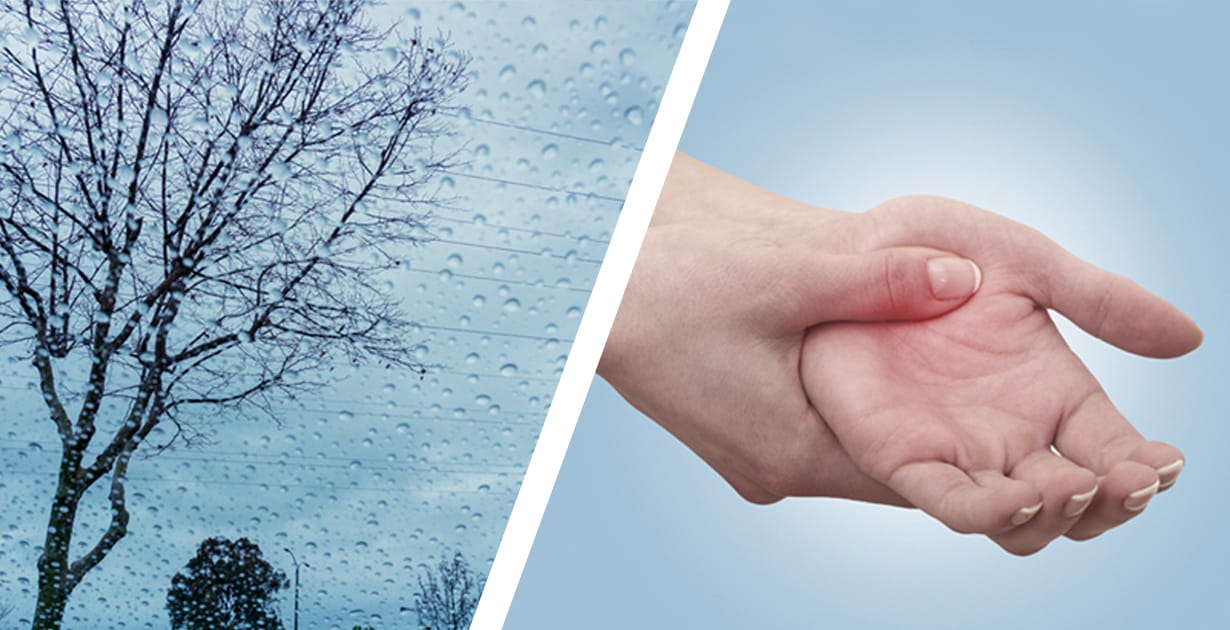
How Climate Affects Arthritis
Before diving into specific locations, it's important to understand how climate can influence arthritis symptoms. Research suggests that several factors can play a role:
-
Temperature: Cold weather can cause the fluid inside joints to thicken, leading to increased stiffness and pain. In fact, one study showed that pain increased with every 10-degree drop in temperature. Conversely, warmer temperatures have been associated with increased gout attacks and a worsening of some lupus symptoms.
-
Humidity: High humidity may exacerbate swelling in joints, intensifying pain.
-
Barometric Pressure: Changes in air pressure can cause tissues to expand or contract, potentially leading to discomfort.
-
Sunlight: While sunlight is a source of vitamin D, which is important for bone health, some medications for arthritis can increase sensitivity to sunlight. This is known as photosensitivity and is something to be aware of, especially for those with lupus.
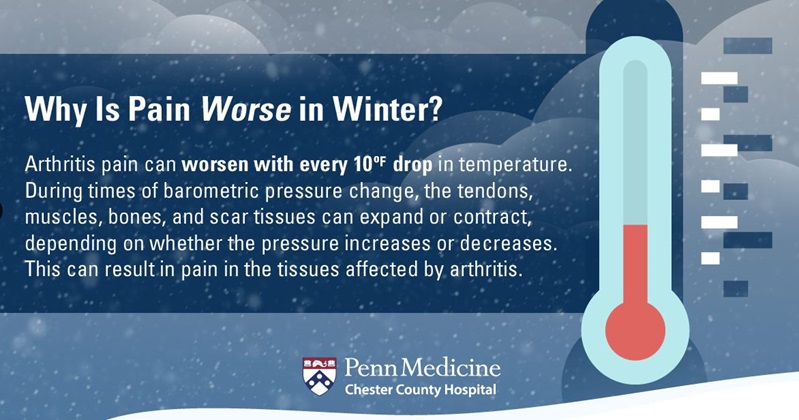
Furthermore, it's important to note that the impact of weather on arthritis can vary significantly among individuals and may differ depending on the type of arthritis. For example, people with osteoarthritis generally prefer warm and dry weather, while those with rheumatoid arthritis tend to prefer cooler weather. Warm weather may also improve symptoms for some people with psoriatic arthritis.
In addition to the direct effects of weather on joints, other factors can contribute to increased pain perception. For instance, stretches of cloudy or rainy days may lead to low mood, which may cause people to focus more on their pain. On cold, rainy days, patients may also be less likely to be out and active, and a lack of physical activity is known to worsen joint pain and stiffness.
While the exact relationship between weather and arthritis is complex and varies between individuals, many people find that warm, dry climates offer the most relief.
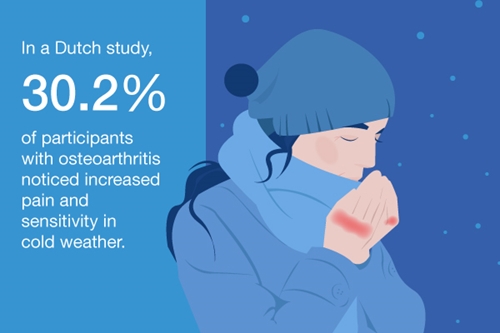
Lifestyle Management for Arthritis
While climate plays a significant role in managing arthritis symptoms, lifestyle factors are equally important. Here are some key strategies for managing arthritis:
-
Stay Warm: If your joints don't like the cold, it's crucial to stay warm. This can involve layering up with warm clothing, using heating pads or electric blankets, and taking warm baths to help loosen stiff joint.
-
Get Moving: Regular exercise is one of the best things you can do to manage arthritis pain and keep your joints healthy. Physical activity helps boost energy, increase strength and flexibility, and release endorphins, which can help ease pain.
-
Stretch Regularly: Stretching, especially before and after exercise, can help loosen stiff joints and reduce the risk of injury.
-
Eat a Healthy Diet: A balanced diet rich in omega-3 fatty acids, found in fatty fish, nuts, and seeds, may help reduce inflammation. Limiting sugar and refined carbohydrates is also beneficial.
-
Maintain a Healthy Weight: Maintaining a healthy weight can significantly reduce stress on your joints, especially weight-bearing joints like knees and hips.
-
Ensure Sufficient Vitamin D: Vitamin D deficiency is common and can contribute to increased arthritis pain and bone loss. It's essential to get your vitamin D levels checked and supplement accordingly if needed.
-
Sun Protection: For those with photosensitivity or lupus, sun protection is crucial. This includes spending time in the shade, wearing protective clothing, and using sunscreen with a high SPF.
-
Monitor Weather Patterns: Keep an eye on the weather forecast and plan activities accordingly. The Arthritis Foundation even has a tool that helps predict the risk of weather-related discomfort for your area.
By combining these lifestyle strategies with a suitable climate, you can create a comprehensive approach to managing your arthritis and improving your overall quality of life.
Environmental Factors and Arthritis
In addition to climate and lifestyle, environmental factors can also influence arthritis. Research suggests that exposure to certain pollutants may increase the risk and severity of arthritis, particularly rheumatoid arthritis. For example, living in urban areas or near highways has been linked to an increased risk of rheumatoid arthritis, potentially due to exposure to pollutants like dioxin.
Furthermore, studies have shown that a combination of environmental factors, such as air and water quality, building type, and socioeconomic status, can contribute to an increased risk of arthritis. This highlights the importance of considering the overall environment when choosing a place to live with arthritis.
Warm and Dry Regions in Spain
Several regions in Spain stand out for their warm, dry climates, which can be particularly beneficial for people with osteoarthritis:
-
Andalusia: Located in southern Spain, Andalusia boasts a Mediterranean climate with hot, dry summers and mild winters. Cities like Seville, Cordoba, and Malaga offer a blend of cultural attractions, modern amenities, and a relaxed lifestyle. Seville is known for its scorching summers, with temperatures often exceeding 30°C. Cordoba, located inland, also experiences hot summers, with temperatures reaching 46.9°C in July 2017.
-
Murcia: Situated in southeastern Spain, Murcia is known for its semi-arid climate with low humidity and plenty of sunshine. The region offers a variety of coastal towns and cities with beautiful beaches and a relaxed atmosphere. Murcia reached a record temperature of 46°C (115°F) in July 1994.
-
Valencia: The southern part of the Valencia region, including the Costa Blanca, enjoys a warm Mediterranean climate with mild winters and plenty of sunshine. Cities like Alicante and Torrevieja offer a mix of coastal living and cultural attractions.
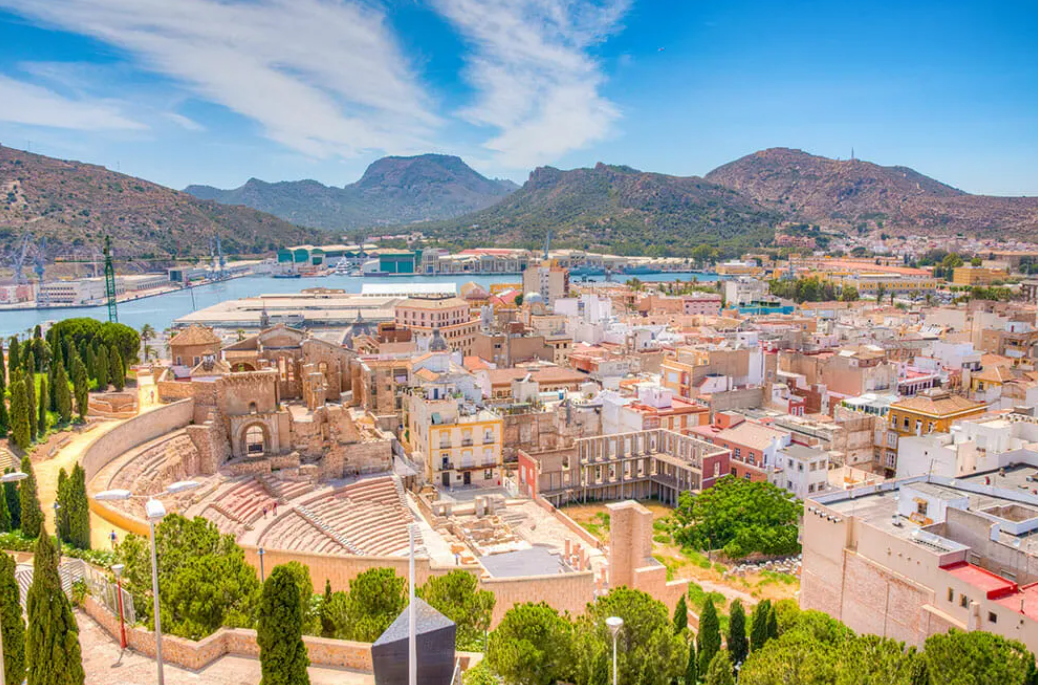
Cities with Good Healthcare and Infrastructure
Within these regions, several cities stand out for their good healthcare facilities and infrastructure:
Andalusia
-
Seville: Seville has major hospitals equipped with high-tech equipment and offers both public and private healthcare options. Seville is also renowned for its flamenco dancing, vibrant festivals like the April Fair and Holy Week, and a rich culinary tradition.
-
Malaga: Malaga boasts a range of excellent hospitals, including the Hospital Regional Universitario, Quirón Hospital, and Vithas Xanit International Hospital. As the birthplace of Pablo Picasso, Malaga has numerous museums and art galleries, and a lively atmosphere with a mix of traditional and modern influences.
-
Marbella: Marbella is home to some of the best hospitals in Spain, including the Hospital Costa del Sol and the Quirón Marbella. Marbella offers a luxurious lifestyle with beautiful beaches, upscale resorts, and a vibrant nightlife.
Murcia
-
Murcia City: Murcia has several well-equipped hospitals, including the Hospital General Universitario Virgen de la Arrixaca and the Quirónsalud Murcia Hospital. Murcia offers a blend of historical sites, natural parks, and a strong agricultural tradition with a focus on local produce and cuisine.
-
Cartagena: Cartagena has two major hospitals, the Hospital General Universitario Santa María del Rosell and the Hospital General Universitario Santa Lucía, offering a range of medical services. Cartagena is a coastal city with a rich maritime history, a well-preserved walled city, and a vibrant cultural scene with influences from Africa, Spain, and indigenous cultures.
Valencia
-
Valencia City: Valencia has a number of internationally recognized hospitals, including La Fe Hospital and the IVO oncology center. Valencia boasts a modern infrastructure with excellent transportation networks, including a high-speed train connecting it to Madrid.
-
Torrevieja: Torrevieja has a modern private hospital, Hospital Quirónsalud Torrevieja, and is also within easy reach of larger hospitals in Alicante. Torrevieja is a lively city with a mix of Spanish and international residents, known for its beautiful beaches, salt lakes, and a relaxed atmosphere.
Choosing the best place to live in Spain with arthritis depends on individual preferences and needs. However, based on the research, Andalusia, Murcia, and Valencia offer a combination of warm, dry climates, good healthcare facilities, affordable living costs, and a welcoming culture. Cities like Seville, Malaga, Cordoba, Murcia, and Torrevieja stand out as particularly attractive options.
It's important to remember that managing arthritis effectively often requires a personalized approach. What works for one person may not work for another, and it's crucial to consider your specific needs and preferences when making a decision.
Before making a move, it's highly recommended to visit different locations at different times of the year to experience the climate and culture firsthand. This will help you determine which location best suits your individual needs and lifestyle.
Ultimately, finding the right place to live in Spain can be a significant step towards improving your quality of life with arthritis.
 2
Like
Published at 11:03 PM Comments (0)
2
Like
Published at 11:03 PM Comments (0)
Discovering Guadix - The cave villlage
Wednesday, February 19, 2025
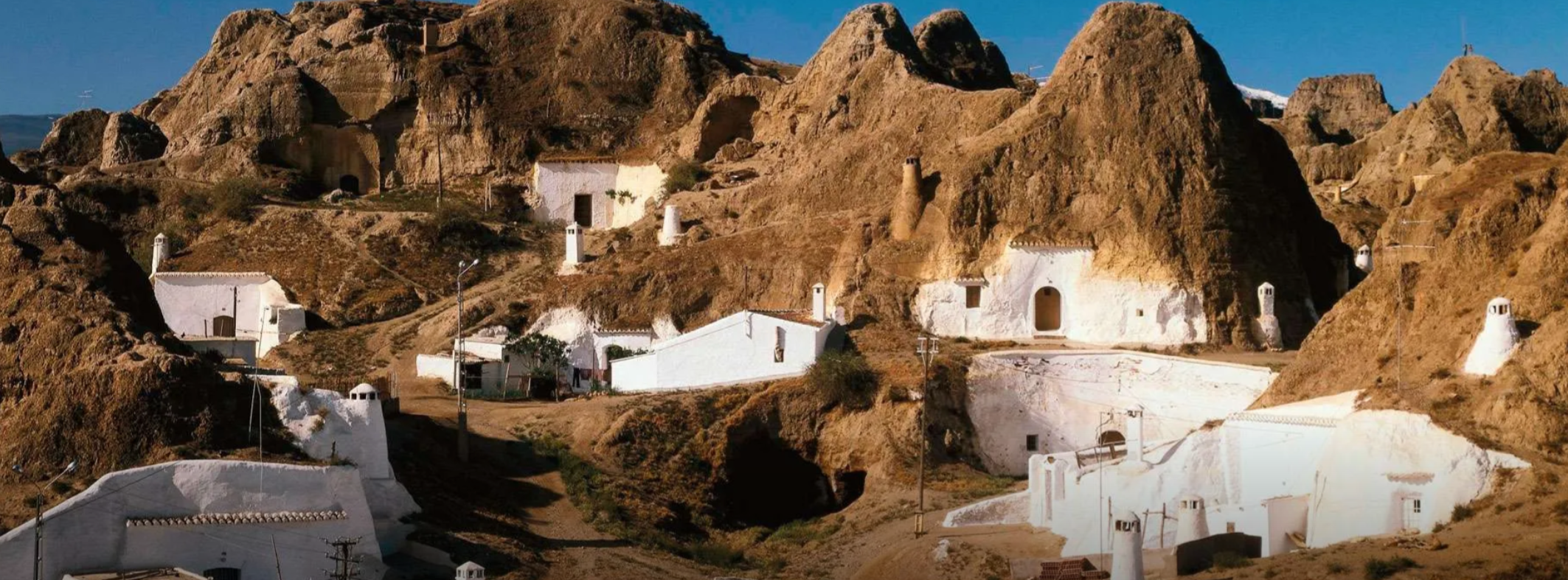
Nestled in the picturesque province of Granada, Spain, lies the quaint town of Guadix, renowned for its unique and historical cave houses. This charming locale is not only celebrated for its subterranean dwellings but also boasts a rich cultural heritage, making it an ideal destination for those longing to immerse themselves in history and architecture.
An Architectural Marvel: The Cave Houses of Guadix
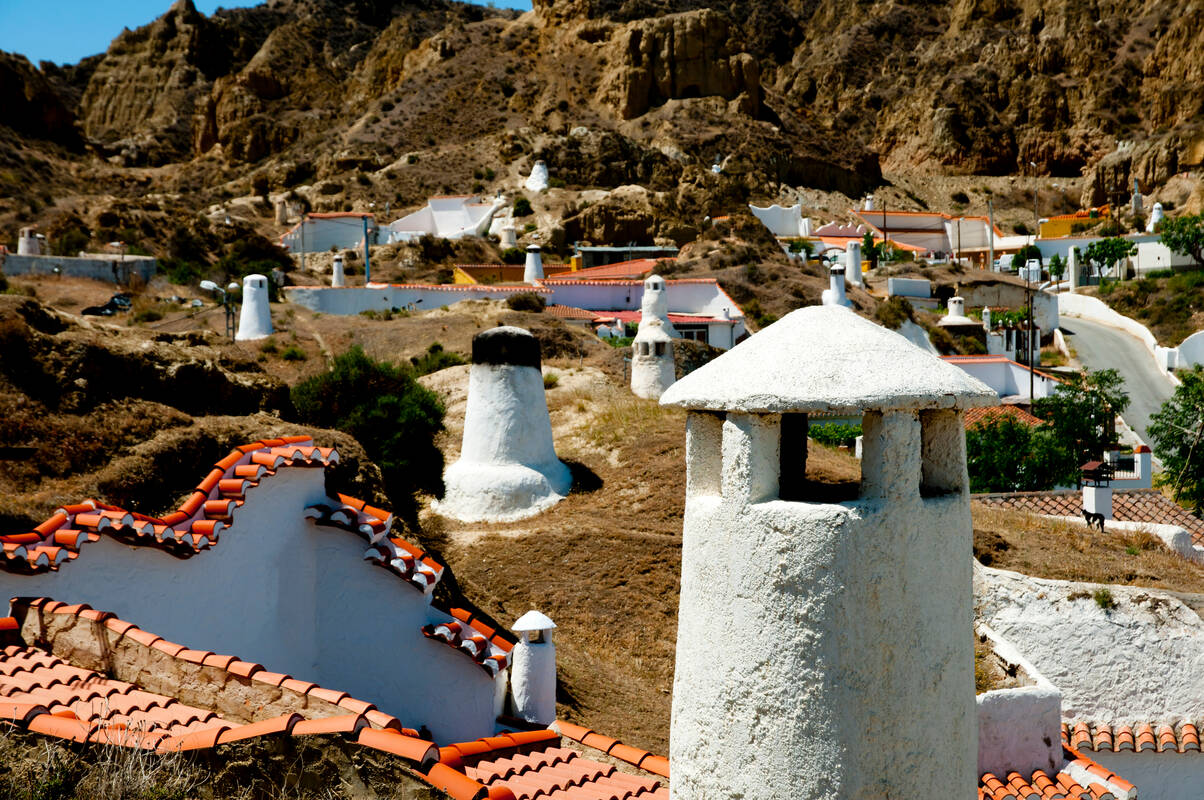
Guadix is distinguished by its extraordinary neighbourhood of cave houses, an impressive example of humanity's adaptability and resourcefulness. These homes, meticulously carved into the mountains, exhibit a remarkable form of vernacular architecture that dates back centuries. The inhabitants have ingeniously utilised the region’s clay-rich soil, renowned for being both easily excavatable and exceptionally durable, to construct these remarkable abodes.
The natural insulation provided by these cave houses is noteworthy; they maintain a comfortable temperature of around 20ºC throughout the year, offering a pleasant refuge from the scorching summer heat typical of the region.
Historical Essence: A Glimpse into Guadix's Past
One of the oldest settlements on the Iberian Peninsula, Guadix’s history stretches back to prehistoric times. Archaeological findings reveal that the area has been inhabited since the Palaeolithic era. Under Roman rule, the town, known as Acci, flourished as a crucial commercial and administrative hub.
The town’s name, Guadix, is derived from its Islamic era name, Wadi Ash, reflecting its deep-rooted Muslim heritage. During Moorish rule, significant infrastructure, including the citadel which still stands today, was developed. The Muslim influence is distinctly seen in the town’s culture and architectural design.
The concept of cave houses proliferated during the Muslim period when Berbers, exploiting the geological advantage, carved out these underground dwellings. These homes provided effective insulation against the harsh climatic conditions. Post the Christian Reconquest in the 15th century, these cave houses served as refuges for expelled Moriscos.
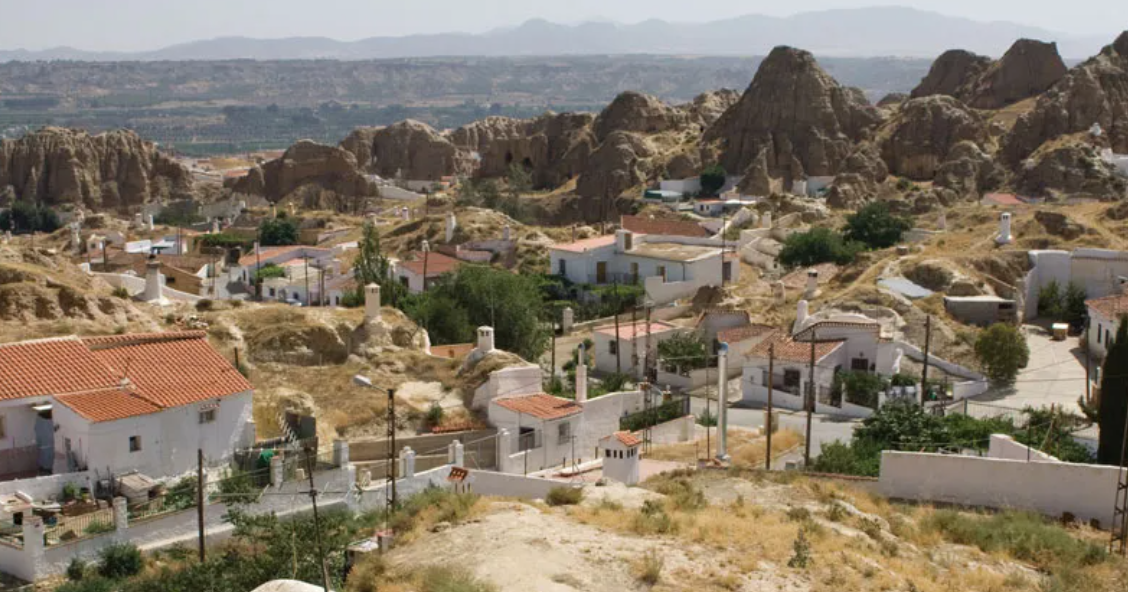
Must-Visit Attractions in Guadix
Guadix is a treasure trove of historical and cultural landmarks. The town offers a variety of attractions that seamlessly blend its architectural splendor with its stunning landscapes.
Alcazaba of Guadix: Constructed in the 11th century, this fortress stands as a testament to the town’s ancient defensive architecture. Its reddish hue and imposing keep are its most striking features. Currently, efforts are underway to restore this historic monument.
La Encarnación Cathedral: A magnificent structure embodying Renaissance and Baroque architectural styles, the construction of this cathedral commenced in the 16th century. It is among the most iconic landmarks in Guadix.
The Cave Houses: A visit to Guadix would be incomplete without touring its famous cave houses. These unique homes provide an incredible insight into traditional living and their modern adaptations include restaurants and hotels, making for an extraordinary experience.
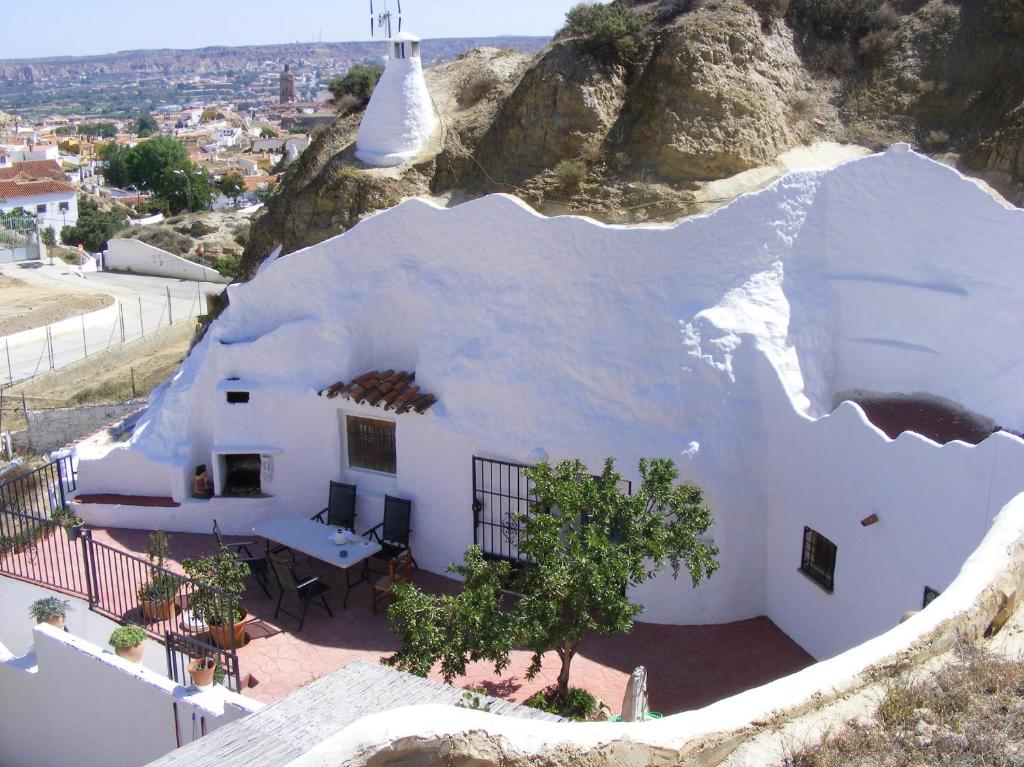
Villalegre Palace: This historic building is a perfect example of the architectural elegance of the past, adorned with Renaissance details that enhance its grandeur.
Santiago Church: Renowned for its beautifully decorated façade and ornate interiors, this church is a quintessential point of interest for enthusiasts of sacred art.
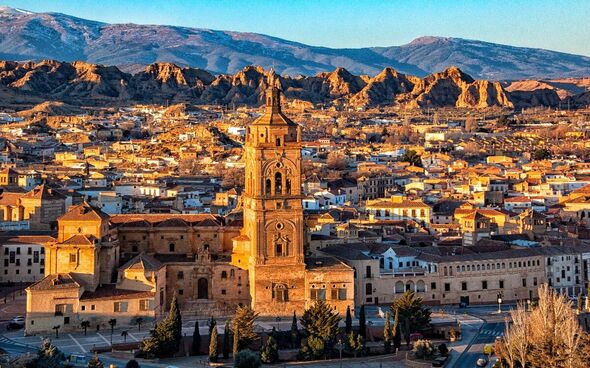
Getting to Guadix
Reaching Guadix is straightforward, with multiple transport options available:
By Car: The town is conveniently located approximately 45 minutes from Granada via the A-92 motorway, which offers direct access.
By Train: Guadix boasts a train station with regular connections to Granada and Almería, making train travel an efficient choice for visitors.
By Bus: Various bus companies provide direct routes to Guadix from different parts of Andalusia, making it an economical option for those not wishing to drive.
Embracing Life in Guadix
Living in Guadix represents the perfect blend of tranquillity and vibrancy. The town’s rural setting promises a serene lifestyle complemented by a welcoming community and rich traditions. Guadix enjoys a pleasant climate year-round, an extensive array of traditional Andalucian cuisine, and a closely-knit community spirit.
Nature enthusiasts will revel in the opportunities for outdoor activities such as hiking and cycling, while the proximity to Granada ensures access to employment opportunities and broader services. The quality of life in Guadix is truly exceptional, offering a balance of peaceful living with convenient access to urban facilities.
 0
Like
Published at 6:15 PM Comments (0)
0
Like
Published at 6:15 PM Comments (0)
Torcal de Antequera
Saturday, February 15, 2025
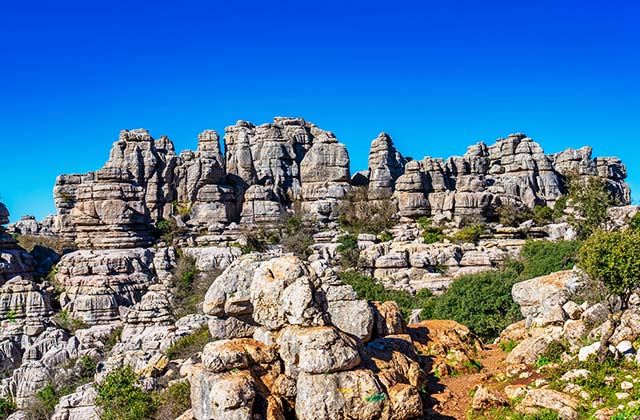
The Torcal de Antequera area is one of the best-kept secrets in the national territory of Spain. It has been declared a World Heritage Site by UNESCO and is one of the most spectacular natural settings in Europe.
Located in the municipalities of Antequera and Villanueva, in La Concepción in the province of Malaga, this natural area is one of those that has positioned itself among the favourites of travellers who are committed to rural tourism, and who decide to get away from the big cities and crowded coastlines.
Before reviewing its main attractions, it is important to remember that we are talking about a protected natural space within the RENPA ( Red de Espacios Naturales Protegidos de Andalucía) therefore, those who are passing through must comply with certain mandatory regulations, which are designed precisely to preserve the practically virgin environment.
That being said, the best thing about Torcal de Antequera is its many trails, most of which lead to incredible viewpoints; without forgetting the Torcal Alto Visitor Center, the meeting point for travellers, and the place where the basic services of this area are offered.
There are several ways to enjoy this area, either through a free visit or by hiring a guided tour, in which an expert guides the group through the essential points that must be seen in the area, which makes sense for all first-time visitors.
Additionally, there are other activities, such as astronomical observations, summer night events, and excursion plans suitable and recommended for the whole family. To discover more visit:
http://www.torcaldeantequera.com/
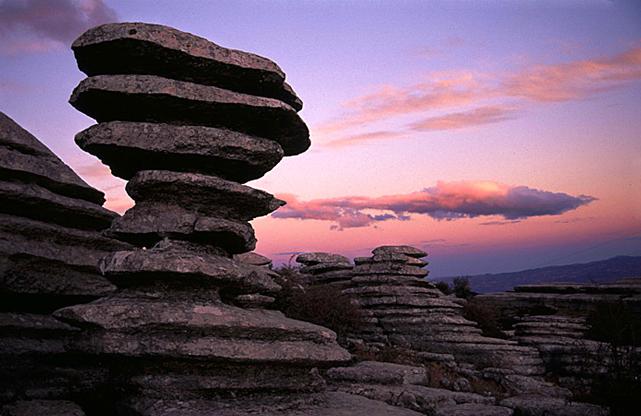
At more than 1,200 meters above sea level, the Torcal de Antequera also requires that we take certain precautions before embarking on the getaway, such as buying or renting mountain clothing, especially boots, coats and backpacks to be well prepared.
With no opening or closing hours, it is always advisable to take the mountain road as soon as the sun rises to make the most of the day. Among its marked trails, which are three, there are two that have been adapted for people with reduced mobility.
Undoubtedly, the El Torcal Natural Park is characterized by the impressive Karstic landscape.
Its formation is due to a process that has lasted several hundred million years. To understand this we must go back some 200 million years, when much of Europe and the Middle East were submerged under the Tethys Sea, a process of carbonate sedimentation begins, caused by the accumulation and deposit of skeletons, shells and shells of marine animals at the bottom of the sea that will last about 175 million years. These sediments have been accumulating and compacting at different levels, forming horizontal strata thousands of meters thick.

Towards the middle Miocene, as a consequence of the thrust between the Iberian plates to the north of the Tethys Sea and the African plate to the south, the accumulated sediments are compressed, deformed and fractured until they emerge in a slow and continuous process that is still ongoing. Once the relief emerged, the prolonged action of meteorological agents such as water, ice and wind on the limestone, modelled the spectacular karstic landscape of El Torcal de Antequera.
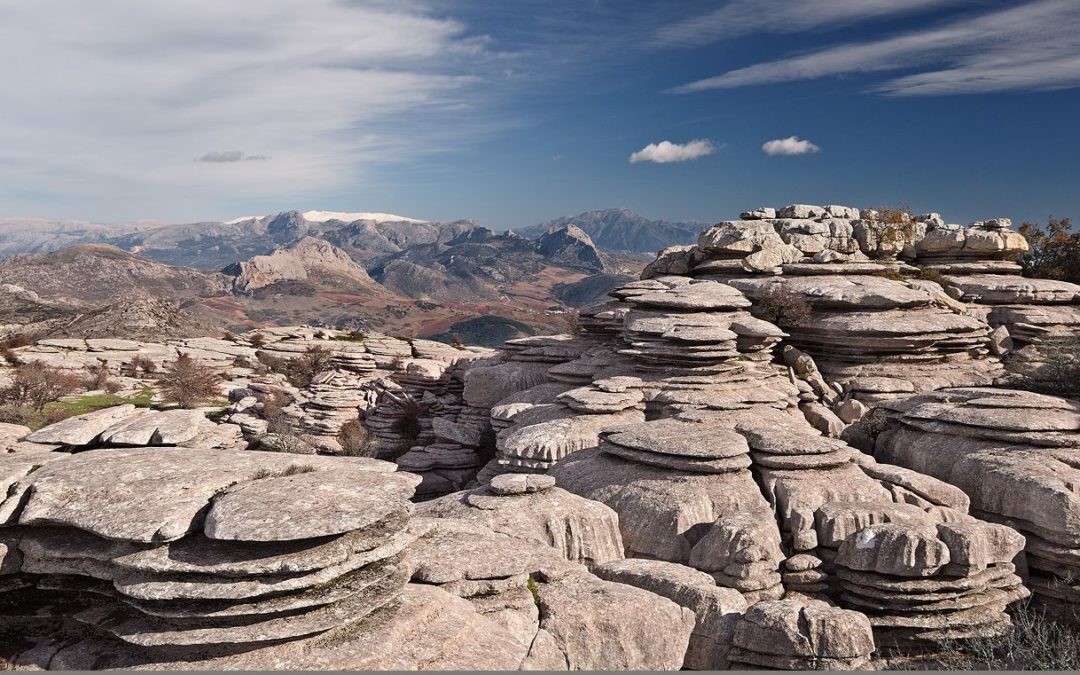

The geological structure of the El Torcal Natural Park is another aspect that has favoured the process of limestone dissolution. A large mushroom-shaped fold, with a very wide upper part and horizontal strata, and short, abrupt flanks, limited by important fractures, favours the accumulation of water on the surface and its infiltration. The karst behaves like a large sponge, it stores rainwater and transmits it to the interior, thus favouring underground dissolution, to finally evacuate it back to the outside through its lowest part, along the entire perimeter. The most important spring in The Torch is the Nacimiento de La Villa, located on the north face.
Apart from the karstic landscape that we can all appreciate with a simple glance, we have to take into account the characteristic endokarstic system in this type of terrain and that in El Torcal translates into more than a thousand potholes and caves formed by the dissolution of limestone.
 2
Like
Published at 12:48 PM Comments (0)
2
Like
Published at 12:48 PM Comments (0)
February Festivals in Spain
Wednesday, February 5, 2025
February is a month of vibrant festivities in Spain, where the cold winter air is warmed by the excitement of various celebrations across the country. From the enchanting Carnival of Santa Cruz de Tenerife to the melodious sounds of the Moors and Christians Festival, Spain offers a diverse array of cultural events and celebrations that captivate both locals and tourists alike. Let's dive into the key highlights of Spain's February festivals, each with its own unique charm and allure.

Carnival Festivities in Santa Cruz de Tenerife (31 January 2025 - 09 March 2025)
One of the most spectacular events on Spain's festival calendar is the Carnival of Santa Cruz de Tenerife. This lively and colourful celebration takes place over several weeks and is renowned for its elaborate costumes, joyful parades, and electrifying atmosphere. The carnival officially kicks off at the end of January and continues until early March, giving visitors ample opportunity to partake in the festivities. Street parties, musical performances, and vibrant dances fill the air as the city goes all out to celebrate this grand event.
The highlight of the carnival is the grand parade, known as "Gran Coso Apoteosis." This extravagant parade showcases intricately designed floats, vibrant costumes, and a rhythmic blend of music and dance. The energy and enthusiasm of the participants are infectious, making it an unforgettable experience for attendees.
Carnival in Águilas (22 February 2025 - 21 March 2025)
Another must-see carnival in Spain is the Carnival in Águilas, which takes place from late February to mid-March. Known for its unique and humorous approach, this carnival stands out for its comedic groups known as "chirigotas." These groups perform satirical songs and skits, which are both entertaining and thought-provoking. The events are a display of wit and creativity, drawing large crowds eager to witness the spectacle.
The Águilas Carnival also features a series of parades, with participants donning extravagant costumes that add to the carnival's lively atmosphere. The "paper bullet" battle, known as "La Batalla de Don Carnal" and "La Batalla de Doña Cuaresma," is a unique and entertaining tradition where participants playfully throw paper confetti at each other, symbolising the battle between Carnal (carnival) and Lent.
Moors and Christians Festival in Bocairent (07 February 2025 - 11 February 2025)
The Moors and Christians Festival in Bocairent is a captivating event that commemorates Spain's historical battles between the Moors and Christians. Held in early February, this festival is steeped in tradition and history, transforming the town into a scene from the past. Participants dress in elaborate costumes representing the Moors and Christians, re-enacting battles and parades to celebrate their heritage.
The festival also includes a series of religious ceremonies, fireworks, and musical performances. The highlight is the procession of the patron saint, Saint Blas, through the streets of Bocairent. The townspeople and visitors alike join in the celebrations, making it a truly immersive and educational experience.
Animac: International Animated Film Festival (20 February 2025 - 23 February 2025) - Lleida
For animation enthusiasts, the Animac International Animated Film Festival in Lleida is a must-attend event. Taking place in late February, this festival celebrates the art of animation, showcasing a diverse range of animated films from around the world. The festival provides a platform for both established and emerging artists to exhibit their work, while also offering workshops, masterclasses, and discussions on various aspects of animation.
Animac is an excellent opportunity for animation aficionados to immerse themselves in the latest trends, techniques, and storytelling methods in the animation industry. The festival's friendly and inclusive atmosphere fosters creativity and innovation, making it a hub for networking and inspiration.
Athletics: Seville Marathon (23 February 2025)
For sports enthusiasts, the Seville Marathon is a key event in February. Held on 23 February 2025, this marathon attracts runners from around the world, eager to take on the scenic route through the historic streets of Seville. The marathon is known for its flat course, making it an ideal event for both seasoned runners and beginners.
The Seville Marathon is more than just a race; it's a celebration of athleticism and community spirit. Spectators line the streets to cheer on the runners, creating an encouraging and supportive atmosphere. The event also includes a variety of activities and entertainment options for participants and their families, making it a memorable experience for all.
Traditional Fiesta of the Carnival Bullfights (28 February 2025 - 04 March 2025) - Ciudad Rodrigo
The Traditional Fiesta of the Carnival Bullfights is a significant event in the Spanish cultural calendar, held from 28 February to 04 March 2025. This event combines the excitement of bullfighting with the festive spirit of carnival, creating a unique and thrilling experience for attendees.
The bullfights are held in various locations throughout the country, drawing both locals and tourists who come to witness this traditional spectacle. The event is steeped in history and tradition, reflecting Spain's deep connection to bullfighting as a cultural practice. The carnival atmosphere adds an extra layer of excitement, with parades, music, and dances complementing the bullfighting events.
Carnival of Herencia (22 February 2025 - 05 March 2025) - Ciudad Real
The Carnival of Herencia is another vibrant celebration that takes place in late February and early March. Known for its lively parades and colourful costumes, this carnival is a joyful event that brings the community together. Participants of all ages take part in the festivities, showcasing their creativity and enthusiasm.
The carnival features various competitions, musical performances, and traditional dances, making it a fun-filled event for the entire family. The grand parade is the highlight of the carnival, with elaborately decorated floats and costumed participants filling the streets with music and laughter.
Carnival of Miguelturra (28 February 2025 - 09 March 2025)
The Carnival of Miguelturra, held from 28 February to 09 March 2025, is another popular carnival in Spain. This event is renowned for its vibrant and inclusive atmosphere, welcoming participants from all walks of life. The carnival features a mix of traditional and contemporary elements, creating a unique and dynamic celebration.
The festivities include parades, costume contests, musical performances, and various cultural activities. The "Burial of the Sardine," a traditional event that symbolises the end of the carnival, is a highlight of the festivities. This humorous and symbolic act involves the mock burial of a sardine, marking the conclusion of the carnival season.
Badajoz Carnival (28 February 2025 - 09 March 2025)
The Badajoz Carnival, taking place from 28 February to 09 March 2025, is one of the largest and most famous carnivals in Spain. Known for its lively and energetic atmosphere, the Badajoz Carnival attracts thousands of visitors each year. The event features a series of grand parades, music, dances, and costume contests that highlight the creativity and spirit of the participants.
The carnival's main parade, known as the "Comparsa Parade," is a spectacular display of colourful costumes, elaborate floats, and rhythmic music. Participants compete for various awards, showcasing their talent and dedication. The Badajoz Carnival is a true celebration of culture, creativity, and community, making it a must-see event for anyone visiting Spain in February.
February in Spain is a month filled with joyous celebrations, cultural events, and vibrant festivities. From the grand parades of the Santa Cruz de Tenerife Carnival to the romantic re-enactments at the Bodas de Isabel de Segura, there is something for everyone to enjoy. Whether you're a fan of traditional festivals, culinary delights, or athletic events, Spain's February festivals offer a rich and diverse experience that will leave you with unforgettable memories. So, mark your calendars and get ready to immerse yourself in the vibrant and enchanting world of Spanish festivals.
 2
Like
Published at 10:53 PM Comments (0)
2
Like
Published at 10:53 PM Comments (0)
La Barca Beach - Fuerteventura
Saturday, February 1, 2025
The Canary Islands have a natural environment characterized by volcanic landscapes and paradisiacal beaches, which have little to envy those of the Caribbean. Its fine white sand, along with crystal clear turquoise waters make each of them a place worth visiting.
In addition, as if that were not enough, some of them keep a hidden secret that further increases their landscape value. This is the case of la Barca beach - Fuerteventura, in which a gigantic lagoon forms when the tide is high. This reaches about 4 kilometres in length and about half a meter deep, constituting a natural phenomenon that delights anyone who goes there.
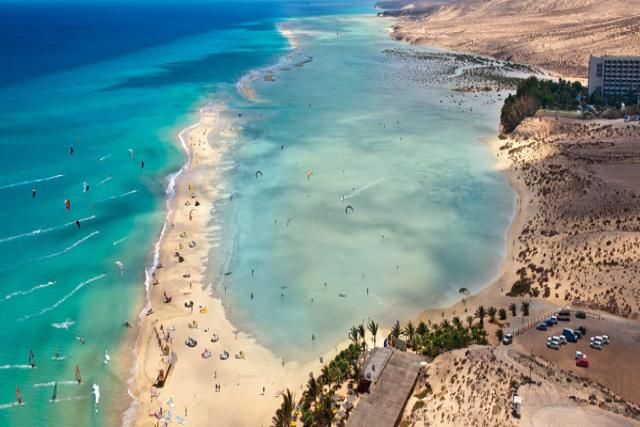
This spectacular beach is located within the municipality of Pajara, in the northern area of Sotavento beach, in Fuerteventura, and is considered one of the best beaches on the entire island. Its white sand extends between 100 meters and 300 meters from the shore and is not usually very crowded, which avoids crowds.
One of the characteristics of this beach is the wind, which during the vast majority of the year is usually strong. This has given it one of the most important events in the world of Windsurfing and Kiteboarding, as it has been the venue for the world championship for more than 30 years.
This competition has given it international fame by bringing together thousands of people who love these sports. In addition, during those days the tourist offer congregates in what is known as the "Carpa", an area where you can enjoy a wide range of activities, gastronomy and nightlife. Events such as 'The 80's Party', 'Beer Party' or 'White Party', among others, are also held there.
 3
Like
Published at 12:48 AM Comments (0)
3
Like
Published at 12:48 AM Comments (0)
Spam post or Abuse? Please let us know
|
|